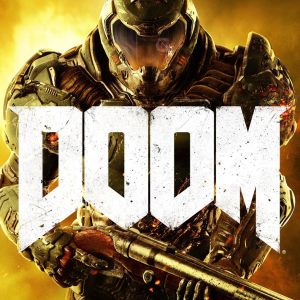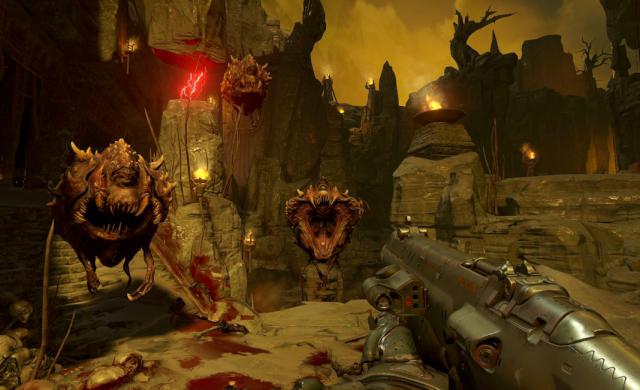
I’ve just shot a demon in the face with a shotgun. It felt good. It felt REALLY good. Not because I’m some kind of anti-demon violent weirdo (although I’m pretty sure I wouldn’t queue up to be mates if a gateway to Hell ever actually opened up) but because it wasn’t any old shotgun. It was an id Software shotgun. The kind of shotgun which sent enemies flying backwards in the awesome and underrated Rage.
The kind of shotgun I was wielding 20 years ago in a fantastic PC game called Doom.
Doom’s comeback onto modern consoles stands out for several reasons; the visuals are great (although not top of the pile great, but still great), the enemies are updates on the traditional Doom nasties, the music takes you back to the 90s with a typically Doom-like industrial soundtrack and there are loads of hidden (and largely pointless in game terms) collectables around the place for you to hunt for off the beaten track. But what really gave me a buzz was the weapons. Those stereotypically Doom weapons. The shotgun is the first weapon you get over and above your basic pistol, and it’s amazing from the first shot you take. There’s no L2-based aiming (that’s not the Doom way), just lots of shells, lots of bad guys, and lots of spraying red stuff when the two combine. But press on and the chainsaw will turn up, the machine gun will turn up, and eventually the all-conquering BFG will turn up. All here, all brutal, all amazing.
When the storyline likes to stick its head up and make an appearance it’s pretty vague; you’re situated up on Mars and there’s a gateway to Hell which has flooded the place with fairly unpleasant and unfriendly demons. You wake up in a facility, manage to escape but will need to keep clearing areas from demons before moving on, all in the name of saving the planet from certain annihilation. As you press through the game the situation gets more urgent, more demons flood towards you, bigger and faster demons come for you, and the whole time you’re throwing yourself round in circles, running away, strafing bad guys in a way that you probably haven’t since the original Doom. Sure you might’ve had some high-octane chases in Call of Duty while you frantically try to shake the person running after you with two stupidly overpowered guns, or enjoyed some strafe-driven rooftop ballet moments in a Resistance matchup, but this is proper, full on, 90s power-strafing interrupted only by the occasional boom of your shotgun or sound of tearing flash as you pounce on a nearly-dead enemy and perform one of the incredibly gruesome but absurdly satisfying one-button finishing moves.
As if the weapons weren’t cool enough from minute 1, you’ll find hovering robots dotted around which provide upgrades to your weapons and allow new abilities like launching grenades from your shotgun, or firing a super-powered shot from your basic pistol. Further challenges introduced at the beginning of the levels also award points which can be spent upgrading weapons and armour, and give you something extra to aim for while slaughtering ever-growing numbers of bad things. It’s easy to get transfixed by them too; I spent about 20 minutes trying to kill two demons with a single blast of my shotgun, but it felt great when it finally happened.

The only criticism I’d have though of the main campaign is that it gets a bit samey if you play it for long sessions. Levels are huge but don’t vary a great deal from the moment you enter to the point you leave, although this could be a result of the setting: there are only so many colours you can get out of an industrial Mars setting. If you only play a level or two at a time then you might not notice, but if you’re the kind of gamer who likes to rush through as quickly as possible then you might not get the same enjoyment. You might still love it, don’t get me wrong, but I found it far better in bursts.
Move across to the online multiplayer and you’ll find the usual array of multiplayer modes, albeit with slightly different names to what you’ll be used to. The only mode I hadn’t seen before was Freeze Tag, whereby you need to kill your opponents (which freezes them) and have them all frozen at once to win. The complication is that you can revive your frozen teammates, so there’s a good amount of teamwork at play. The idea of reviving fallen teammates isn’t a new one, but when the whole game revolves around you tracking them down and helping them it certainly adds a very fun and tense edge to things.
But the real ace up Doom’s sleeve (if games have sleeves) is the SnapMap option, letting you build your own levels using a series of pretty straightforward tools. You can start off with a basic template then add on whatever combinations of corridors, areas, corners, demon spawn points and various other items that you want. There are already some very cool maps being made with this, and with the ability to share your creation with whoever will pay attention there’s an almost limitless amount of content to try out. I don’t understand why other FPS developers don’t create a similar service, other than the fact it would impact on revenue from expensive DLCs which only offer a couple of new maps. It’s a shame, as LittleBigPlanet proved on several occasions, some people are very, very clever when it comes to making their own levels.
So would I recommend Doom? Hell yes (pardon the pun). Anyone younger than 30 might not really get the same tingle from the nostalgia element, but it’s still a balls-out fast-paced shooter which stands up against almost anything else available currently. It’s a very different game to others on offer, but that’s no bad thing. This is refreshing, brutal, and great fun. And when all is said and done, that’s a very important factor.
Reviewed on PS4


Leave a Reply